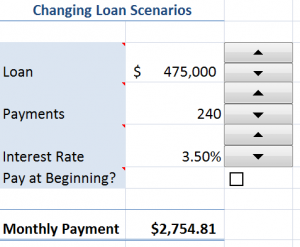An Excel Form is great way to distribute an Excel worksheet to your customers or field representatives. Most of the time, you do not want them to type values into a cell. You want to make this Form as “user friendly” as possible! You want to add “Spin Buttons” to your form, so that the user can simply click to change cell values up or down in the increments that you want to display.
A perfect example: A Mortgage Loan Scenario where – by clicking the Spin Buttons – your client can see what their monthly payment will be. This is my second lesson covering Excel’s Form Control Tools. Watch as I demonstrate how to “work around” the Form Controls limits of Maximum Amount for a Spin Button (30,000) and also how to increment interest rates by 1/4 of a Percent.
From personal observation, I know that many people start to create an Excel Form and then just give up in frustration. I did too – in the beginning! Watch me demonstrate how to avoid the traps of the “got’cha” steps in this short Excel Training Video.
Check out the great tips that I offer on my DVD, “The 50 Best Tips for Excel 2007.” Click here to start shopping.
Learn how you can “Master Excel in Minutes – Not Months!”
 Create User Friendly Excel Forms with Spin Button Controls [ 8:54 ] Play Now | Play in Popup | Download (1298)
Create User Friendly Excel Forms with Spin Button Controls [ 8:54 ] Play Now | Play in Popup | Download (1298)
